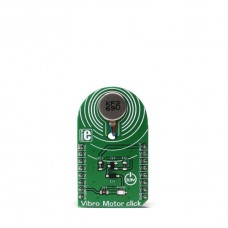Vibro Motor click
Vibro Motor click features a compact size Eccentric Rotating Mass (ERM) motor, labeled as C1026B002F. This type of motor is often used for haptic feedback on many small handheld devices, such as the cellphones, pagers, RFID scanners and similar devices. This motor contains a small eccentric weight on its rotor, so while rotating it also produces vibration effect. This kind of motors is sometimes referred to as coin motors, due to its shape.
Besides the vibration motor, the click is also equipped with the DMG3420U, a small MOSFET, which is used to drive the motor. The Vibro Motor click is an ideal solution for adding a simple, one pin driven haptic feedback on any design.
How does it work?
The click uses the DMG3420U MOSFET to drive the ERM motor, since the MCU itself cannot provide enough power for the motor driving. The circuit also contains a protection diode, which is used to protect the transistor from the reverse voltage, since the motor represents an inductive load and turning off its current can produce a kickback voltage that can damage the transistor.
.jpg)
The gate of the MOSFET is driven by the PWM signal, routed through the PWM pin of the mikroBUS™. The PWM signal toggles the gate of the MOSFET with the pulses of a certain width. As a result, the current through the motor is varied depending on the pulse width of the PWM signal, which directly affects the speed of the motor, effectively controlling the vibration force that way. The small, eccentric weight attached to the rotor of the coin motor, generates the centrifugal force while it rotates, which in turn results with the wobbling effect of the motor itself. The faster the rotation is, the bigger the force gets. Controlling the motor speed allows for the vibration intensity to be controlled.
MikroElektronika library contains functions that are used to easily drive the motor by changing the PWM pulse width, saving time for the application firmware development.
Specifications
| Type | DC |
| Applications | An ideal solution for adding a simple, one pin driven haptic feedback on any design. |
| Key Features | Low power consumption, compact size |
| Interface | PWM |
| Input Voltage | 3.3V |
| Click board size | M (42.9 x 25.4 mm) |
Pinout diagram
This table shows how the pinout on Vibro Motor click corresponds to the pinout on the mikroBUS™ socket (the latter shown in the two middle columns).
Vibro Motor click specifications
| Description | Min | Typ | Max | Unit |
|---|---|---|---|---|
| Rated ERM motor speed | 9000 | RPM | ||
| Bracket deflection strength | 9.8 | N | ||
| Mechanical noise | 50 | dB | ||
| Operating Temperature | -20 | +60 | °C |
Onboard settings and indicators
| Label | Name | Default | Description |
|---|---|---|---|
| VM | Vibro motor | - | Vibration motor |
| PWR | Power LED | - | Power LED indicator |
Software support
We provide an example for Vibro Motor click on our LibStock page, as well as a demo application (example), developed using MikroElektronika compilers. The demo can run on all the main MikroElektronika development boards.
Examples description
This demo application demonstrates how to control Vibro Motor click by using the MCU's PWM module. The demo application is composed of two sections:
- systemInit - Initializes the PWM module
- applicationTask - Sequential call of each pattern with 1 second delay in between
Additional functions:
void vibromotor_pattern1(uint8_t loops)- Long vibration pattern - 1 second vibration + 1 second delay
void vibromotor_pattern2(uint8_t loops)- Short vibration pattern - 200 ms vibration + 500 ms delay
Other mikroE Libraries used in the example:
- PWM
Additional notes and information
Depending on the development board you are using, you may need USB UART click, USB UART 2 clickor RS232 click to connect to your PC, for development systems with no UART to USB interface available on the board. The terminal available in all MikroElektronika compilers, or any other terminal application of your choice, can be used to read the message.
mikroSDK
This click board is supported with mikroSDK, the MikroElektronika Software Development Kit. To download mikroSDK visit LibStock. For more information about SDK, visit the official page.
Downloads
mikroBUS™ standard specificationsLibStock Vibro Motor click library
C1026B002F datasheet
Enter the code in the box below:





